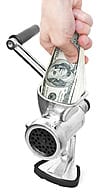
In most plastic surgery circles, “deal” is a four-letter word. Whether we like it or not, in this economy patients have been known to try to negotiate your surgical fees. If you haven’t seen this in action yet, don’t worry. You will.
Price is just a dollar amount, but value is the relative worth or desirability of a product or service to the end user. The difference between price and value can be huge. In today’s market, you have to review every offering in your practice based on the value proposition, both to you and your patients.
For example, your time or staff time to counsel patients and perform the procedure has to be factored into the overall value equation. Add to that the cost of technology, disposables, and marketing required to bring the patient in the door. Therefore, the highest-priced procedure you offer may not be the most profitable one.

If you know the needs and desires of your patient population, you can create new opportunities for practice growth and remain competitive. Carefully review your pricing decisions and offer special incentives, or bundle or package products or services to enhance value for your clients. The goal is not necessarily to offer the lowest price in your community, but to establish a belief among your customers that they are receiving a good value from your practice.
Start by reviewing your local competition to assess pricing relative to yours. Also, review your local market to determine what procedures are still popular among patients and which may be enjoying a growth spurt.

Turn your attention to inside your practice. Perhaps you can enhance a particular product or service and create a greater demand among your existing patients.
You should position your practice as bargain basement, good value for the money, or haute couture. The challenge with opting for the most elite positioning is that there are far fewer patients willing to pay premium prices to go around these days. But if you go the bargain basement route, it will be very tough to raise your fees to an acceptable level in the future.
The safest bet is to offer value for the quality of services you provide. Patients are less willing to overpay for services that are readily available everywhere today. One tactic that has worked well in many regions is to select a few procedures as your loss leader to draw patients in. By definition, a loss leader is a product or service that is offered at cost or below cost to stimulate the purchase of other more profitable products or services.
Supply and demand plays an important role in your local market and pricing considerations. If you work in a high-supply, low-demand market, such as Manhattan or Southern California, where there are more practitioners offering the services you offer and not enough patients to fill their waiting rooms, your prices charged have to reflect that reality.
It may be necessary to lower your pricing to be more competitive and encourage higher procedure volumes.
Customer response can be a critical tool to determine the ideal pricing structure. Speaking with patients directly or conducting a survey to determine how they feel about the value of your products or services can also provide you with needed insight.
It is wise to revisit your pricing structure periodically to stay on top of the trends in your market. By paying close attention to price versus value, you may be able to identify areas where you can reduce costs while improving the quality of your products and services.
Always keep the evolving needs of your community and patient population in mind. Consumers may surprise you by showing their appreciation and loyalty if you are willing to adjust your policies to meet their needs.
Wendy Lewis is president of Wendy Lewis & Co Ltd global aesthetics consultancy, author of 10 books, and a regular contributor to PSP. You can reach her at and on Twitter at COSMETICMED.




